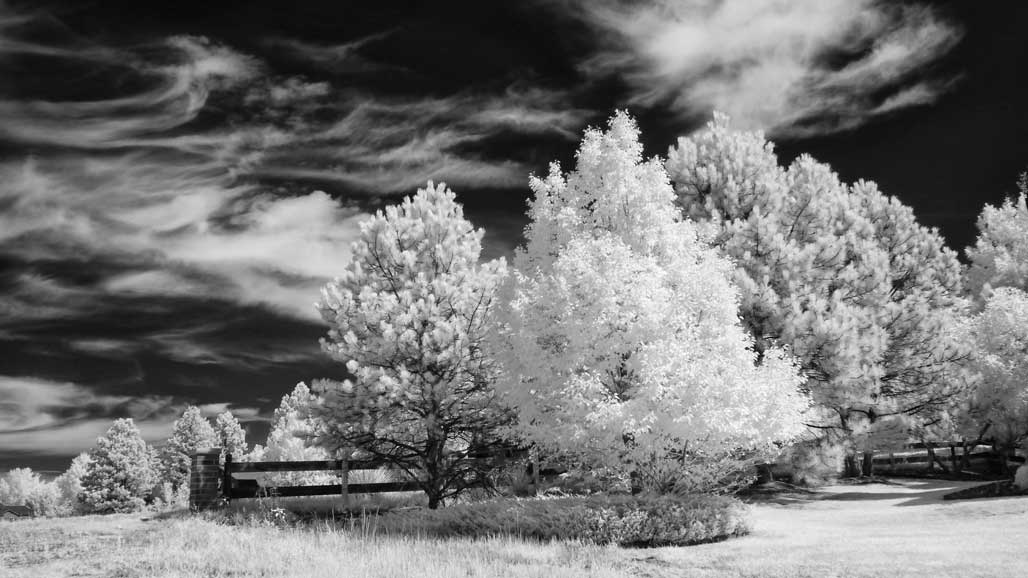Today’s Post by Joe Farace
In the Spring, I have counted 136 different kinds of weather inside of 24 hours.— Mark Twain
With that quote, Mr. Clemens might have been talking about this Spring in Colorado. Spring has been slow coming to Colorado and snowstorms have stunted and damaged some of the deciduous trees here on Daisy Hill as well as many of the trees in McCabe Meadows, all of which has been slowing down my annual foray into digital infrared photography.
 Any photograph that you make is about lighting but infrared photography is more about capturing images with invisible light, which is why comparisons to traditional photography can be difficult. If you want to create a dramatic image, few things beat a sunrise photographed in its vibrant colors. The same scene photographed in infrared might be disappointing unless there’s some IR reflective subject matter in the frame.
Any photograph that you make is about lighting but infrared photography is more about capturing images with invisible light, which is why comparisons to traditional photography can be difficult. If you want to create a dramatic image, few things beat a sunrise photographed in its vibrant colors. The same scene photographed in infrared might be disappointing unless there’s some IR reflective subject matter in the frame.
Infrared images have a dreamlike look that’s produced by something known as the Wood Effect, and is mainly caused by foliage such as tree leaves and grass that are strongly reflecting infrared light in the same way that visible light is reflected by snow. There is some minor contribution from chlorophyll fluorescence but it’s not the real cause of the brightness that can be seen in infrared photographs. This effect is named after infrared photography pioneer Robert W. Wood (1868-1955) and not after the material wood, which does not strongly reflect infrared.
I’m not Robert wood but here’s one of Farace’s Laws that applies to infrared photography: If the lighting looks great for traditional subject matter it’s probably not going to work as well for infrared photography. Conversely, the worst possible light, such as High Noon, is perfect for infrared capture. Don’t just take my word for it; you should experiment because you never know for sure what the results will be when working in infrared.
 There are no ‘official’ subjects for digital IR photography although I take a crack at the subject on my car photography website/Blog. Summer landscapes with leafy deciduous trees, lots of grass, and puffy clouds often produce a great infrared picture but evergreens, like the Ponderosa Pines shown above here on Daisy Hill, don’t reflect as much infrared but depending on the invisible light will reflect some IR light.
There are no ‘official’ subjects for digital IR photography although I take a crack at the subject on my car photography website/Blog. Summer landscapes with leafy deciduous trees, lots of grass, and puffy clouds often produce a great infrared picture but evergreens, like the Ponderosa Pines shown above here on Daisy Hill, don’t reflect as much infrared but depending on the invisible light will reflect some IR light.
 I’ve found that Life Pixel does a great job with IR conversions and they’ve done most of the conversions for my Canon DSLRs and all of my Panasonic Lumix G-series cameras. This is not a paid or sponsored endorsement, just my experience.
I’ve found that Life Pixel does a great job with IR conversions and they’ve done most of the conversions for my Canon DSLRs and all of my Panasonic Lumix G-series cameras. This is not a paid or sponsored endorsement, just my experience.
My book, The Complete Guide to Digital Infrared Photography is available from Amazon for $17.79 with used copies starting around $13.79 as I write this. Creative Digital Monochrome Effects has a chapter on IR photography and is available from Amazon for $9.39 with used copies starting around two bucks, as I write this.